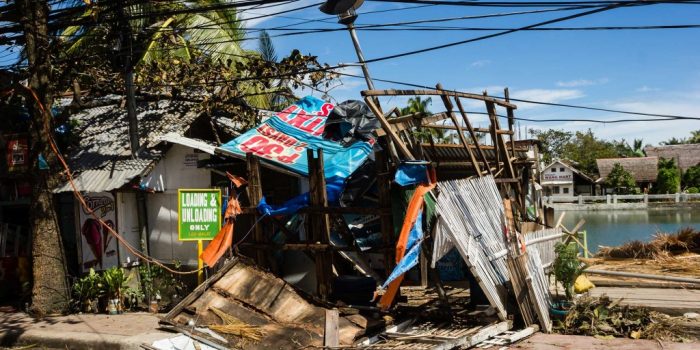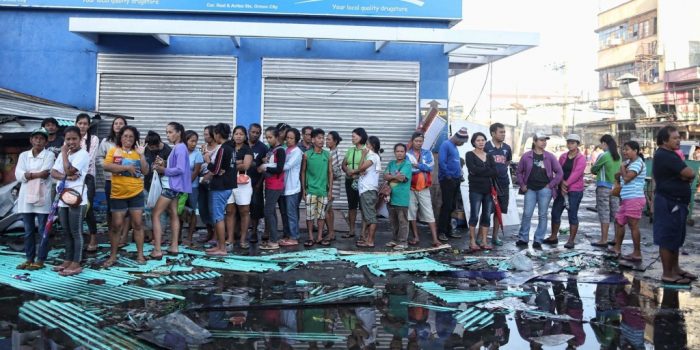Life after a Super Typhoon
Typhoon Haiyan was the strongest tropical cyclone to hit landfall in world history, with winds nearly 195 mph it slammed into the coast of the Philippines. (The previous record was held by Hurricane Camille in 1969, which made landfall in Mississippi with 190 mph winds.) Haiyan was also the deadliest and most costly tropical typhoon […]

Typhoon Haiyan was the strongest tropical cyclone to hit landfall in world history, with winds nearly 195 mph it slammed into the coast of the Philippines. (The previous record was held by Hurricane Camille in 1969, which made landfall in Mississippi with 190 mph winds.) Haiyan was also the deadliest and most costly tropical typhoon in the history of the Philippines, killing over 6,000 people.
According to Jeff Masters, the director of meteorology and co-founder of Weather Underground, the Philippines has experienced the three most expensive natural disasters in history in a 12-month time span: Super Typhoon Haiyan in November 2013 ($13 billion), Super Typhoon Bopha in December 2012 ($1.7 billion), and the torrential rains in and around the capital city of Manila in August 2013 ($1.7 billion). A major earthquake in early 2013 did additional damage.
The amount of destruction to commerce and agriculture is hard to comprehend. According to the Philippines Bureau of Fisheries and Aquatic Resources, 21 of the country’s 72 fishing provinces and over 145,000 fishermen were affected by the storm. In some areas up to 95 per cent of boats and fishing equipment were lost. The UN’s Office for the Coordination of Humanitarian Affairs (OCHA) estimates that 33 million coconut trees were damaged or destroyed. Restoring productive farming and fishing resources will take a longterm and expensive effort.
Of greater concern are the conditions for over 10 million people affected by Haiyan. According to a front page story in the Washington Post, “[Haiyan] … has left in its wake one of the most profound resettlement crises in decades, with the number of newly homeless far exceeding the capacity of aid groups and the government to respond. For those who lose homes in a disaster, there’s almost never a quick solution, aid workers say. The Katrina-hit Gulf Coast had its infamous FEMA trailers. Port-au-Prince had its squalid tent cities. Northeastern Japan had its cramped evacuation centers — mostly schools and civic centers — the last of which closed only last month, almost three years after a tsunami and a series of nuclear meltdowns. What’s noteworthy in the Philippines, though, is not where people are resettling, but rather the degree to which they are staying put. Across the disaster zone, some 90 percent are still living in the same plot they were occupying before the typhoon.”
On March 18 at 1 p.m. EDT, we’ll hear from three experts who are deeply involved in the Haiyan relief effort:
- Sebastien Trives, United Nations Office for the Coordination of Humanitarian Affairs (OCHA)
- Carolyn Miles, President and CEO, Save the Children
- Tavia Robb, Celebrity Cruiselines, and a major donor to Typhoon Haiyan relief
As with most disasters hitting the 4-month mark, short-term recovery efforts from Typhoon Haiyan are wrapping up, and the the area is moving into long-term recovery mode. As the rebuilding process begins, we check in on the state of vulnerable populations in the area. We will examine questions including:
- How did the Typhoon affect the elderly, women and children, the disabled, and other vulnerable populations differently from others?
- What efforts have been made to provide assistance to these populations, and what needs remain unmet?
- Who are the key players left to do this long and arduous task of rebuilding?
- How will they go about rebuilding homes and communities, especially when more than 10,000 destroyed homes are in areas now declared “no building zones”?
- What are local NGOs doing to help people get back to work and to some sense of normalcy?
Learn more and sign up here for our CDP Issues and Insights Webinar. We hope you can join us or check back for a summary after the event on our event highlights page.
More like this

